SUNNY SUNDAY WITH SPURGE BUGS (and some other insects)
Not many plants on the dry coastal meadows in my area have flowers to offer these days ...
... so these juicy, yellow islands surrounded by the sea of desiccated grass, are in the center of attention ...

... for me ... and many insects in search for sap, nectar and other free vegetarian products.
When it comes to nectar, the plant produces plenty of that sweet, edible stuff ...
... but the sap of the spurge, it's a tricky meal. It's dense, white, very milk - like ... and toxic for most animals. For most, doesn't mean for all, of course. The species on this, and the following few photographs ...
... has no problem with poison in its food. On this triptych, you can see the small wingless nymph of the Dicranocephalus agilis bug sucking the milky juice through its piercing proboscis.
While I was photographing the small bug ...
... an ant entered the scene.

The ant was collecting the nectar while the bug was feeding on the sap. On this photograph, it looks that the minuscule ant is consuming the nectar from the petals of the tiny flower ... but ...

... the nectar on this plant is found on the surface of the nectar producing glands that resemble some kind of thick, succulent petals. The usual, kind of "classic", disposition of flower parts and their function is something you won't find on Euphorbia plants. On this photograph, you can see the minuscule Spermophagus sericeus beetle. The larvae of this species feed and develop exclusively in the tiny bindweed fruits, but adult beetles, although most commonly found on bindweed flowers, can be seen feeding on other flowering plants as well.
Here you can see another ant that entered the frame while I was photographing.
This lovely yellow caterpillar looks like some branch or appendage of the plant when seen from a distance.

When I took a better look through the macro lens, I saw it feeding on nectar ... and then ...

... about a half an hour later, the caterpillar was feeding on some dried out plant parts ...

... that looked like seeds or something like that. Maybe it was something that fell from the surrounding vegetation and remained entangled with the flowering parts of the spurge.
I encountered this caterpillar only a couple of times, always on the vegetation near the sea.
I haven't found out the name of the species, but this inchworm is definitely a larval stage of some moth from the Geometridae family.
This creature looked pretty fascinating to me, so I took quite a few very similar, probably slightly unnecessary shots ... and they all ended up in this post.
Quite a few species of spurge grow in the seaside environments in my area. This one, the main vegetal protagonist of the post, is the Euphorbia cyparissias ... commonly known as the Cypress spurge.
Here you can see the small Dicranocephalus agilis nymph cleaning its antennae, one by one. On the following photograph ...
... you can take a look at the much bigger and more developed nymph of the same species.
Nymphs of various size and age are crawling around these days ...

... so, quite strangely, I have the opportunity to show you the growth and development of these bugs through a post that deals with just one day in their life.

At one point, it was late in the afternoon, while sniffing around the Cypress spurge plants ...
... I noticed this minuscule wasp ... and then ...

... I saw another one nearby.

Soon I realized that there is some kind of invasion going on. I counted about twenty little wasps on the plants in front of me.

While I was observing the plants, quite fascinated with this new scene, a robber fly landed very close to me ...
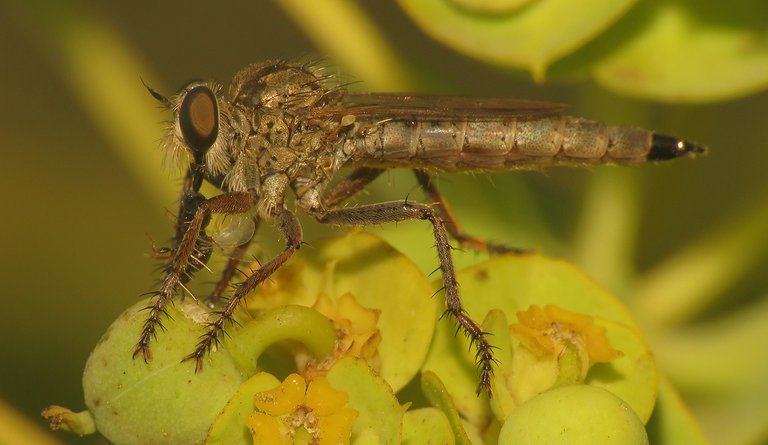
... when I got even closer with the macro lens ...
... I noticed that the predatory fly has just caught one of those wasps.
After taking another enlargeable portrait of a minuscule wasp ...

... I caught another predator.
This is a very small, juvenile lynx spider.

Oxyopes heterophthalmus is the name of the species.
Here you can see the relatively big Formica fusca ant enjoying the nectar of the cypress spurge. With the following photograph ...

... the focus is back on this post's main insect - protagonists ...
... the spurge bugs. After many photographs with young, not completely developed nymphs that you already saw in this post ...
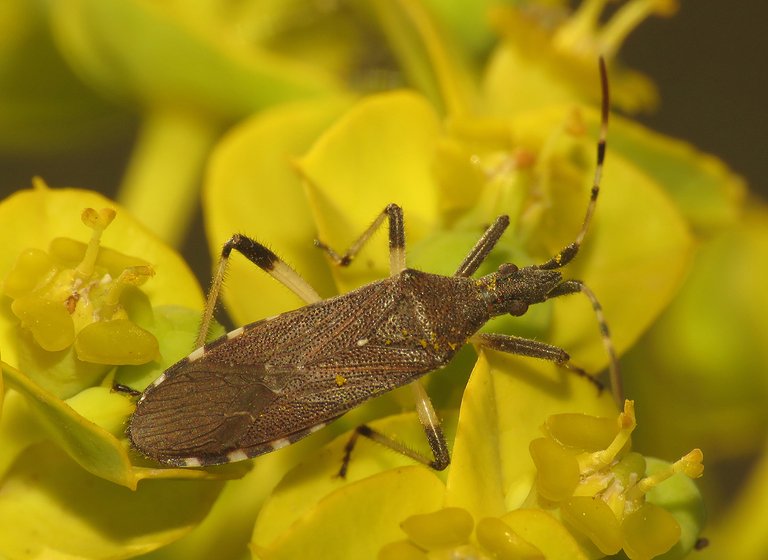
... it's time to introduce an adult, definitive version of the Dicranocephalus agilis bug. I used the flash for most of the photographs in the post, because it helped me reveal all the details and retain the high shutter speed necessary to catch the moving insects ...

... but I also took a couple of photographs using only the natural light ... to convey the real life atmosphere in which I was working to get enough material for this little photo - story.
Here you can see another small beetle that was feeding on the flowers.
This is the Scymnus apetzi lady beetle. It feeds mainly on aphids ... but nectar and pollen can be also good diet supplements for this minuscule species.
I can't tell you much about the insect on this and the following two photographs.
It looks like some very small, elongated wasp ... or something like that ... and I never saw it before or since these photographs were taken. It was feeding on nectar.

The adult spurge bug on this photograph ...

... is standing on the threads ...
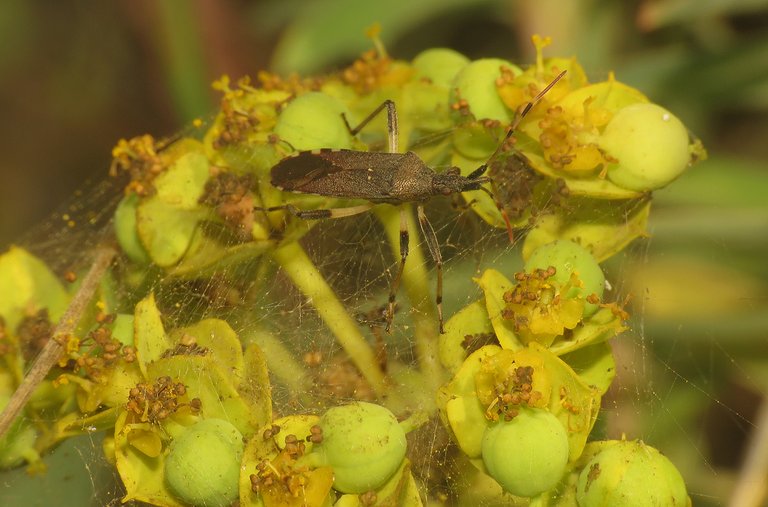
... of the silky structure that has enveloped the entire spurge flowerhead.

Under the cover of that shelter, hidden among the branches and flowers on the top of the plant, I found a small spider. The Kochiura aulica, from the Theridiidae family.

The bug was quietly sucking the sap above the flower, and I took a couple of shots in natural light.

On this photograph, the insect is cleaning the forelegs and the proboscis after the meal.

Later I found more flowerheads enveloped with silk.

Some spurge bugs were nicely posing on the top of the plant ...
... surrounded by various nectar eaters ...

... but most of them were hidden among the foliage on the part of the plant just below the inflorescence.

Also there, on one of the many elongated leaves ...
... I photographed this jumping spider.

I don't know the name of the species.
These two bugs were mating on the top of the plant, at first ... but then ...
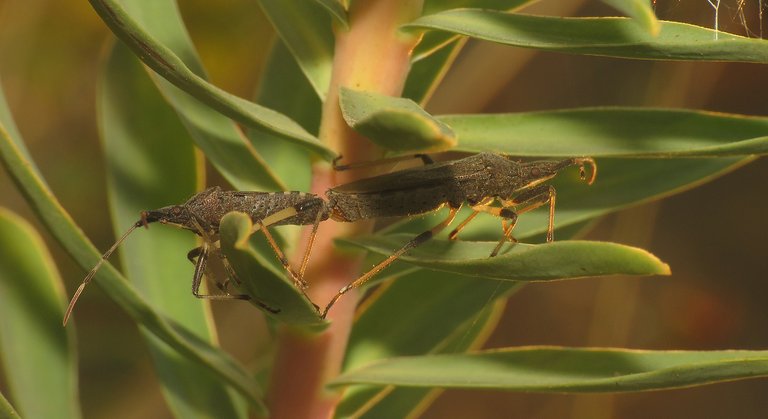
... when they noticed my shadow spreading above the vegetation ...
... the bugs crawled down the stem, to hide among the leaves.
After this shot - I let them be.
Dicranocephalus agilis is a species from the Stenocephalidae family. Bugs from this family are commonly known as the spurge bugs. It's a small group of bugs, with only about thirty described species that all have a very similar appearance. This is one of the only five European species.

Back on the flower - covered top of the cypress spurge ...

... I photographed another interesting bug ... that isn't strictly connected with this kind of plants - the Sehirus luctuosus shield bug.

And now ...

... with the last look at the Euphorbia cyparissias spurge surrounded by various dried out vegetation in a typical summer atmosphere ... it's time to end this post.
As always here on HIVE, the photographs are my work - THE END.


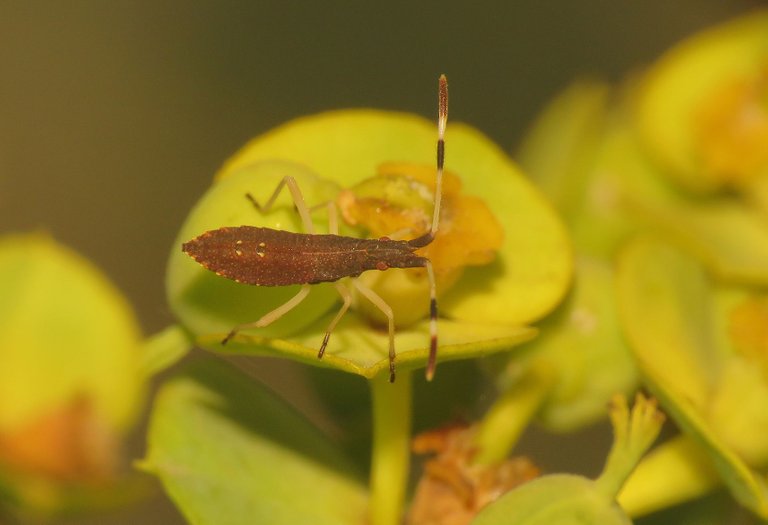











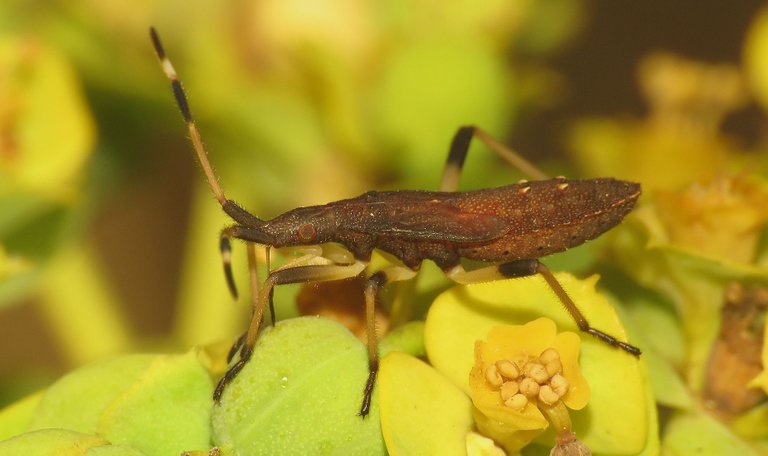



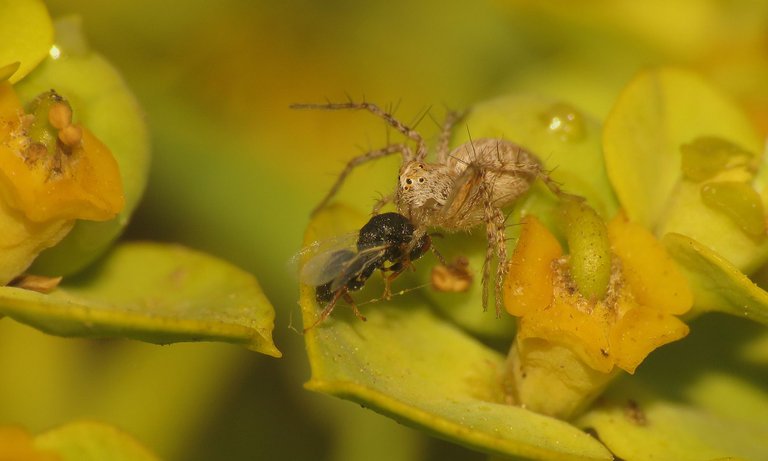











I upvoted you, thank you for posting! 👍
I upvoted you, thank you for posting! 👍
Amazing capture brother 😊
Thank you :)
Another day, another fantastic shots of insects from you. Thanks for sharing.
Thanks. :) Glad you like this kind of posts about nature.
You are welcome buddy. Keep them coming.😄👍
I upvoted you, thank you for posting! 👍
Cool :) Thanks
The yellow flower is beautiful and the insects they are adorable. Amazing Snaps. :)
Thanks. :) Glad you like this look at the small, macro stuff. There is always some action around these plants :)
Hlw
You are a great phografar.Nice collecton.Thanks for share this.
Great microphotography and a great variety of insects that jumping spider looks awesome :)
Thanks. :) Yes, jumping spiders are pretty cute ... a bit like some furry spider teddy bears.
Haha, that's a good descriptions I like that but I would not cuddle it like a teddy bear.
:)
We appreciate your work and your post has been manually curated by zoology team (oscurity,nelinoeva) on behalf of Amazing
Thank you :)
Today I managed to shoot a large spider, which I have never seen in our area, and moreover in the city center ... I was a little scared)
Cool bugs, and the pictures are as always the best on the platform!
Thanks. :) Congratulations on the new spider. It's great to see something you didn't know existed in your area.
Yes. I was a little shocked to see him near the hospital) Today, most likely I will post it)
My Cyprus spurge has come back well this summer. I love these posts of the tiny life on the various plants. Without your camera to capture it all, I'd never see it. :))
I also see many things properly only when I'm photographing through the macro lens. :) In normal view, these are all small dots and particles that are well hidden, camouflaged, or move around too fast.
Hi @borjan,a great variety of insects and scientific names quite difficult to pronounce, better the generic ones :) well I have a hard time pronouncing them, the part that covers the insect is really a shield, it looks very strong, difficult for a predator of this animal it is very protected
Hehe, I also have problems with pronouncing those names :)
I want to say beautiful insects good taste ;))